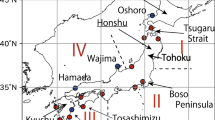Abstract
Based on the Pathfinder sea surface temperature (PFSST), the surface axis and its pattern of the Yellow Sea Warm Current (YSWC) are discussed. A structure of double-warm-tongue is found in February and it varies in different years. Two indexes are calculated to represent the westward shift (WSI) and northward extension (NEI) of the warm water in the Yellow Sea (YS). Wavelet analysis illustrates that the WSI and NEI have prominent periods of 3–6 years and 3–4 years, respectively. The Empirical Orthogonal Function (EOF) decomposition is applied to the winter wind stress curl and the Kuroshio Current (KC) transport, which are believed to play important roles in forcing the variability of the YSWC surface axis. Statistics shows that the WSI is significantly related with the second EOF mode of the wind stress curl in February, which may force the YSWC surface axis moving westward and maintaining the double warm tongues because of its opposite curl in the YSWC domain. The first EOF mode of wind stress curl in January is propitious for inducing the warm tongue in the YS to advance more northward. Hence, the wind stress curls both in January and in February could force variations of the YSWC surface axis; however, the effect of the January wind stress curl is relatively weaker than that of the February. The relationship between the NEI and the KC transport is remarkable, and it seems that the stronger KC supplies more power to push the YSWC northward against the southward wind.
Similar content being viewed by others
References
Beardsley R C, Limeburner R, Yu H et al. 1985. Discharge of the Changjiang (Yangtze River) into the East China Sea. Cont. Shelf Res., 4: 57–76.
Chen X E, Wu D X. 2006. A Preliminary Study on Numerical Simulation of the Northeast Asian Regional Seas, Ocean University of China Press, Qingdao, China. p. 11–12.
Da Silva A M, Young C C, Levitus S. 1994a. Atlas of Surface Marine Data 1994, Volume 3, Anomalies of Heat and Momentum Fluxes, NOAA Atlas NESDIS 8, U.S. Department of Commerce, NOAA, NESDIS, 411pp.
Da Silva A M, Young C C, Levitus S. 1994b. Atlas of Surface Marine Data 1994, Volume 4, Anomalies of Fresh Water Fluxes, NOAA Atlas NESDIS 9, U.S. Department of Commerce, NOAA, NESDIS, 308pp.
Gao G P, Qian C C, Bao X W et al. 2001. Difference between the PFSST and the in-situ data in East China Sea. Acta Oceano. Sinica, 23(4): 121–126. (in Chinese with English abstract)
Guan B X. 1985. The main hydrographic features of shallow water in the Yellow and East China Seas. J. of Oceanogr. of Huanghai & Bohai Seas, 3(4): 1–10. (in Chinese with English abstract)
Guo B H, Zou E M, Xiong X J et a1. 2000. Seasonal variation of water exchange between the Yellow Sea and the East China Sea. Acta Oceano. Sinica, 22(sup): 12–23. (in Chinese with English abstract)
Hsueh Y. 1988. Recent current observations in the eastern Yellow Sea. J. Geophys. Res., 93: 6 875–6 884.
Hsueh Y, Yuan D L. 1997. Currents, heat advection, and sea level fluctuations in the Yellow Sea in winter of 1986. J. Phys. Oceanogr., 27: 2 313–2 326.
Kilpatrick K A, Podesta G P, Evans R. 2001. Overview of the NOAA/NASA Advanced Very High Resolution Radiometer Pathfinder algorithm for sea surface temperature and associated matchup database. J. Geophys. Res., 106(C5): 9 179–9 197.
Le K T, Mao H L. 1990. Wintertime structures of temperature and salinity of the southern Huanghai (Yellow) Sea and its current systems. Oceanol. Limnol. Sin., 21(6): 505–515. (in Chinese with English abstract)
Lie H J, Cho C H, Lee J H et al. 2001. Does the Yellow Sea Warm Current really exist as a persistent mean flow? J. Geophys. Res., 106(C10): 22 199–22 210.
Ma J, Qiao F L, Xia C S et al. 2006. Effects of the Yellow Sea Warm Current on the winter temperature distribution in a numerical model. J. Geophys. Res., 111(C11S04): 1–12.
Mao H L, Ren Y W, Sun G D. 1965. A preliminary analysis of summer hydrographic features and water type (water system) in the southern Yellow Sea and the northern East China Sea. Marine Science Atlas, 1: 78–125. (in Chinese with English abstract)
Nitani H. 1972. Beginning of the Kuroshio. Kuroshio: Its Physical Aspects, ed. by Stommel H & Yoshida K, Univ. of Tokyo Press. Tokyo, Japan. p.129–163.
Tang Y X, Zou E M, Lie H J et al. 2000. Some features of circulation in the southern Huanghai Sea. Acta Oceano. Sinica, 22(1): 1–16. (in Chinese with English abtract)
Tang Y X, Zou E M, Lie H J. 2001. On the origin and path of the Huanghai Warm Current during winter and early spring. Acta Oceano. Sinica, 23(1): 1–12. (in Chinese with English abstract)
Teague W J, Jacobs G A. 2000. Current observations on the developV50_UserGuide.pdf
Author information
Authors and Affiliations
Corresponding author
Additional information
Supported by the National Basic Research Program of China (973 Program) (No. 2005C B422308), the National High-tech Research and Development Program (863 Program) (No. 2006AA09Z149), and the China International Science and Technology Cooperation Program (No.2006DFB21250).
Rights and permissions
About this article
Cite this article
Song, D., Bao, X., Wang, X. et al. The inter-annual variability of the Yellow Sea Warm Current surface axis and its influencing factors. Chin. J. Ocean. Limnol. 27, 607–613 (2009). https://doi.org/10.1007/s00343-009-9159-2
Received:
Accepted:
Published:
Issue Date:
DOI: https://doi.org/10.1007/s00343-009-9159-2




